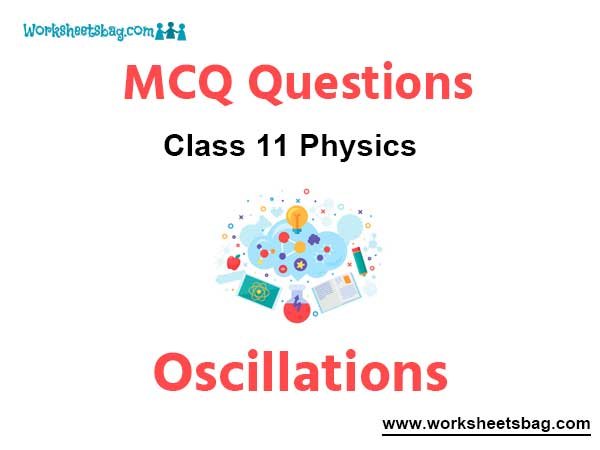Please refer to Oscillations MCQ Questions Class 11 Physics below. These MCQ questions for Class 11 Physics with answers have been designed as per the latest NCERT, CBSE books, and syllabus issued for the current academic year. These objective questions for Oscillations will help you to prepare for the exams and get more marks.
Oscillations MCQ Questions Class 11 Physics
Please see solved MCQ Questions for Oscillations in Class 11 Physics. All questions and answers have been prepared by expert faculty of standard 11 based on the latest examination guidelines.
MCQ Questions Class 11 Physics Oscillations
Question. A child swinging on swing in sitting position stands up. The time period of the swing will
(a) increase
(b) decrease
(c) remain same
(d) increase if the child is tall and decrease if the child is short.
Answer
B
Question. The graph of time period (T) of simple pendulum versus its length (l) is

Answer
A
Question. The graph plotted between the velocity and displacement from mean position of a particle executing SHM is
(a) circle
(b) ellipse
(c) parabola
(d) straight line
Answer
B
Question. A vertical mass-spring system executes simple harmonic oscillations with a period of 2s. A quantity of this system which exhibits simple harmonic variation with a period of 1 s is
(a) velocity
(b) potential energy
(c) phase difference between acceleration and displacement
(d) difference between kinetic energy and potential energy
Answer
B
Question. The potential energy of a particle (Ux) executing S.H.M. is given by

Answer
A
Question. A particle moves such that its acceleration ‘a’ is given by a = – bx where x is the displacement from equilibrium position and b is constant. The period of oscillation is

Answer
B
Question. Acceleration of a particle executing SHM, at it’s mean position is
(a) infinity
(b) variable
(c) maximum
(d) zero
Answer
D
Question. A particle executes S.H.M. having time period T, then the time period with which the potential energy changes is
(a) T
(b) 2 T
(c) T/2
(d) ∝
Answer
C
Question. A rectangular block of mass m and area of cross-section A floats in a liquid of density r . If it is given a small vertical displacement from equilibrium. It undergoes oscillations with a time period T then
(a) T∝ m
(b) T∝ p
(c) T∝1/A
(d) T∝1/ p
Answer
A
Question. Which one of the following equations of motion represents simple harmonic motion?
(a) Acceleration = – k(x + a)
(b) Acceleration = k(x + a)
(c) Acceleration = kx
(d) Acceleration = – k0x + k1x2
where k, k0, k1 and a are all postive.
Answer
A
Question. If the magnitude of displacement is numerically equal to that of acceleration, then the time period is
(a) 1 second
(b) π second
(c) 2π second
(d) 4π second
Answer
C
Question. The graph shown in figure represents

(a) motion of a simple pendulum starting from mean position
(b) motion of a simple pendulum starting from extreme position
(c) simple pendulum describing a horizontal circle
(d) None of these
Answer
A
Question. Out of the following functions, representing motion of a particle, which represents SHM?

(a) Only (A)
(b) Only (D) does not represent SHM
(c) Only (A) and (C)
(d) Only (A) and (B)
Answer
C
Question. The period of oscillation of a mass M suspended from a spring of negligible mass is T. If along with it another mass M is also suspended, the period of oscillation will now be
(a) T
(b) T / √2
(c) 2T
(c) √2 T
Answer
D
Question. A simple pendulum performs S.H.M. about x = 0 with an amplitude a, and time period T. The speed of the pendulum at x = a/2 will be

Answer
A
Question. A tunnel has been dug through the centre of the earth and a ball is released in it. It executes S.H.M. with time period
(a) 42 minutes
(b) 1 day
(c) 1 hour
(d) 84.6 minutes
Answer
D
Question. A particle of mass 1 kg is moving in S.H.M. with an amplitude 0.02 and a frequency of 60 Hz. The maximum force acting on the particle is
(a) 144 π2
(b) 188 π2
(c) 288 π2
(d) None of these
Answer
C
Question. The equation of SHM of a particle is A + 4π2x = 0 where a is instantaneous linear acceleration at displacement x. The frequency of motion is
(a) 1 Hz
(b) 4p Hz
(c) 1/4 Hz
(d) 4 Hz
Answer
A
Question. A simple pendulum has time period ‘t’. Its time period in a lift which is moving upwards with acceleration 3 ms–2 is

Answer
A
Question. Three masses of 500 g, 300 g and 100 g are suspended at the end of a spring as shown, and are in equilibrium. When the 500 g mass is removed, the system oscillates with a period of 2 second. When the 300 g mass is also removed, it will oscillate with a period of

(a) 2 s
(b) 4 s
(c) 8 s
(d) 1 s
Answer
D
Question. The time period of the oscillating system (see figure) is

Answer
B
Question. A particle of mass 10 gm is describing S.H.M. along a straight line with period of 2 sec and amplitude of 10 cm. Its kinetic energy when it is at 5 cm from its equilibrium position is
(a) 37.5π2 erg
(b) 3.75π2 erg
(c) 375π2 erg
(d) 0.375π2 erg
Answer
C
Question. Lissajous figure obtained by combining x = a sin ϖt and y = a sin (ϖt + π/4) will be a/an
(a) ellipse
(b) straight line
(c) circle
(d) parabola
Answer
A
Question. A simple spring has length l and force constant K. It is cut into two springs of lengths l1 and l2 such that l1 = n l2 (n = an integer). The force constant of spring of length l1 is
(a) K (1 + n)
(b) (K/n) (1 + n)
(c) K
(d) K/(n + 1)
Answer
B
Question. Two simple pendulums of length 0.5 m and 20 m respectively are given small linear displacement in one direction at the same time. They will again be in the phase when the pendulum of shorter length has completed oscillations [nT1=(n–1)T2, where T1 is time period of shorter length & T2 be time period of longer wavelength and n are no. of oscillations completed]
(a) 5
(b) 1
(c) 2
(d) 3
Answer
B
Question. A clock which keeps correct time at 20ºC, is subjected to 40ºC. If coefficient of linear expansion of the pendulum is 12 × 10–6 per ºC. How much will it gain or loose in time ?
(a) 10.3 seconds/day
(b) 20.6 seconds/day
(c) 5 seconds/day
(d) 20 minutes/day
Answer
A
Question. When an oscillator completes 100 oscillations its amplitude reduces to 1/3 of its initial value. What will be its amplitude, when it completes 200 oscillations ?
(a) 1/8
(b) 2/3
(c) 1/6
(d) 1/9
Answer
D
Question. A boy is executing simple Harmonic Motion. At a displacement x its potential energy is E1 and at a displacement y its potential energy is E2. The potential energy E at displacement (x + y) is

Answer
B
Question. A particle of mass m is fixed to one end of a light spring of force constant k and unstretched length l. The system is rotated about the other end of the spring with an angular velocity w, in gravity free space. The increase in length of the spring will be

Answer
B
Question. Frequency of oscillation is proportional to

Answer
A
Question. The time period of a simple pendulum of infinite length is (Re = radius of Earth)

Answer
A
Question. A block rests on a horizontal table which is executing SHM in the horizontal plane with an amplitude ‘a’. If the coefficient of friction is ‘μ’, then the block just starts to slip when the frequency of oscillation is

Answer
A
Question. A circular hoop of radius R is hung over a knife edge. The period of oscillation is equal to that of a simple pendulum of length
(a) R
(b) 2R
(c) 3R
(d) 3R/2
Answer
B
Question. In the figure shown, the spring is light and has a force constant k. The pulley is light and smooth and the strring is light . The suspended block has a mass m. On giving a slight displacement vartically to the block in the downward direction from its equilibrium position the block executes S.H.M. on being released with time period T. Then

Answer
D
Question. A point particle of mass 0.1 kg is executing S.H.M. of amplitude of 0.1 m. When the particle passes through the mean position, its kinetic energy is 8 × 10–3 Joule. Obtain the equation of motion of this particle if this initial phase of oscillation is 45º.

Answer
A
Question. A body of mass 0.01 kg executes simple harmonic motion about x = 0 under the influence of a force as shown in figure. The time period of S.H.M. is

a) 1.05 s
(b) 0.52 s
(c) 0.25 s
(d) 0.03 s
Answer
D
Question. A straight rod of negligible mass is mounted on a frictionless pivot and masses 2.5 kg and 1 kg are suspended at distances 40 cm and 100 cm respectively from the pivot as shown. The rod is held at an angle θ with the horizontal nd released. Then

(a) the rod executes periodic motion about horizontal position after the release
(b) the rod remains stationary after the release.
(c) the rod comes to rest in vertical position with 2.5 kg mass at the lowest point
(d) the rod executes periodic motion about vertical position after the release
Answer
B
Question. A forced oscillator is acted upon by a force F = F0 sin wt. The amplitude of oscillation is given by

The resonant angular frequency is
(a) 2 unit
(b) 9 unit
(c) 18 unit
(d) 36 unit
Answer
B
Question. The displacement of a particle is represented by the equation y = 3cos (π/4 – 2ϖ) The motion of the particle is
(a) simple harmonic with period 2p/w
(b) simple harmonic with period p/w
(c) periodic but not simple harmonic
(d) non-periodic
Answer
B
Question. Motion of an oscillating liquid column in a U-tube is
(a) periodic but not simple harmonic
(b) non-periodic
(c) simple harmonic and time period is independent of the density of the liquid
(d) simple harmonic and time period is directly proportional to the density of the liquid
Answer
C
Question. The displacement of a particle varies with time according to the relation y = a sinϖt + b cosϖt.
(a) The motion is oscillatory but not SHM
(b) The motion is SHM with amplitude a + b
(c) The motion is SHM with amplitude a2 + b2
(d) The motion is SHM with amplitude √a2 + b2
Answer
D
Question. The equation of motion of a particle is x = a cos(at)2. The motion is
(a) periodic but not oscillatory
(b) periodic and oscillatory
(c) oscillatory but not periodic
(d) neither periodic nor oscillatory
Answer
C
Question. A particle is acted simultaneously by mutually perpendicular simple harmonic motion x = a cos wt and y = a sin wt. The trajectory of motion of the particle will be
(a) an ellipse
(b) a parabola
(c) a circle
(d) a straight line
Answer
C
Question. A particle executing SHM maximum speed of 30 cm/s and a maximum acceleration of 60 cm/s2. The period of oscillation is
(a) π sec
(b) (π/2) sec
(c) 2p sec
(d) (π/t) sec
Answer
A
Question. When two displacements represented by y1 = asin(ϖt) and y2 = b cos(ϖt) are superimposed the motion is:
(a) simple harmonic with amplitude a/b
(b) simple harmonic with amplitude √a2 + b2
(c) simple harmonic with amplitude (a + b) /2
(d) not a simple harmonic
Answer
B
Question. Four pendulums A, B, C and D are suspended from the same elastic support as shown in figure. A and C are of the same length, while B is smaller than A and D is larger than A. If A is given a transverse displacement,

(a) D will vibrate with maximum amplitude
(b) C will vibrate with maximum amplitude
(c) B will vibrate with maximum amplitude
(d) All the four will oscillate with equal amplitude
Answer
B
Question. A particle is executing a simple harmonic motion. Its maximum acceleration is a and maximum velocity is b. Then its time period of vibration will be :

Answer
C


